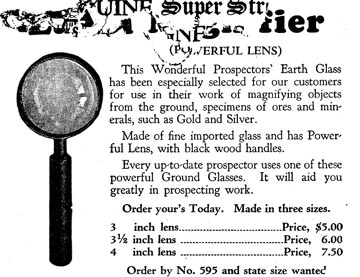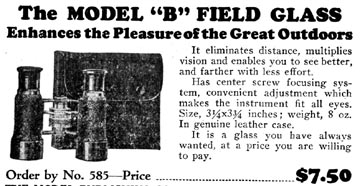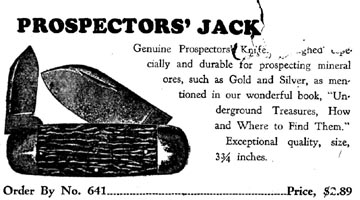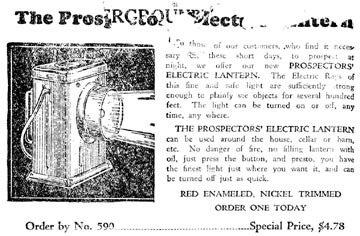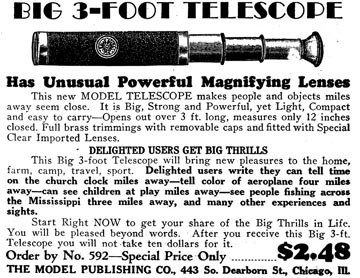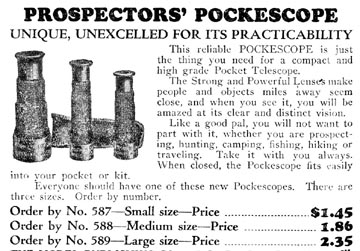 |

| |
|
|  |
The Wonder Instrument Of The Age
While Model Publishing Company had their bundles, they did include a number of useful tools for the prospector -- tools actually identified in the books as things to bring while prospecting. Despite the examination of small objects required for prospecting, distance-viewing has a inordinate emphasis here: a 'pocketscope' (a small telescope), a 3-foot telescope, and field glasses. The pocketknife and magnifying glass are about the most useful of any of the tools advertised in the catalog, but as they're not exactly the most difficult tools to acquire, weren't prominently featured in the catalog. One amazing tool, my favorite, is seen here:
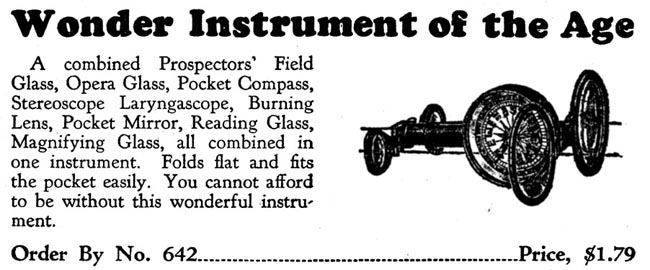
The Wonder Instrument of the Age is numerous things, all wrapped into one: A Prospectors' Field Glass, Opera Glass, Pocket Compass, Stereoscope Laryngascope, Burning Lens, Pocket Mirror, Reading Glass, and Magnifying Glass, all combined in one instrument. A Stereoscope Laryngascope? Unless the prospector is moonlighting as a doctor, I can't imagine why a tool to look down someone's throat could possibly be a selling point. A master of synonyms will quickly notice that the majority of these myriad of tools are lensed tools -- magnifiers of some sort, whether two lenses paired for long distance or a single lens for magnifying small objects. Still, I could see the usefulness of such a compact, functional object, and it shouldn't surprise anyone that younger relatives of the Wonder Instrument of the Age are still being manufactured today.
Labels: model publishing company, prospecting, tools
Discount Prospecting Kits
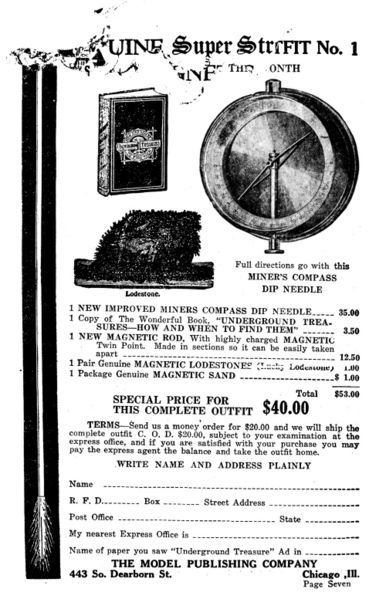 Model Publishing Company devotes several pages to discount collections of different combinations of the prospecting products they offer. Each kit includes a book, a scientific accessory of some sort, a tool of some sort, and something magnetic. The kit, above, is probably the least useful of the kits, but most telling of the rest of the catalog's offerings. This lot would be useful if it stopped at the dip needle and book -- both would be of use to an amateur prospector -- but to include so much magnetic materials with it I can only imagine that, if shipped together, the dip needle would end up severely magnetized in the wrong way. The magnetic rod appears to have some purpose beyond "finding small screws you dropped" and "magnetizing small needles" -- it seems far too deliberate in design, and I'd wager its original purpose is dowsing. There's more convenient ways to use a magnet without designing it into a metal rod with a handle/crook at the top, and advertising its 'magnetic twin point.' One of the rod's selling points is that it is "attracted by all but non-magnetic metals," which seems like a roundabout way of saying it's only attracted to magnetic metals, and seems worded to not discourage those interested in finding other hidden subterranean treasures than an iron ore deposit. In a similar vein, but with a far different purpose, is the inclusion of a lodestone and 'magnetic sand.' While these objects hold little direct application in finding precious metals underground, many people believed (and still do) that good fortune would come to the owner of such materials. A lodestone, for the superstitious and magical, attracts wealth and success as well as it does an iron nail -- the magnetic sand represents those desired aspects of life, and the lodestone the bearer of the good luck charm. As I mentioned, the practice isn't lost to time -- you can still get a lodestone and the cutely-named ' lodestone food' from magical shops. Labels: lodestone, magnetism, model publishing company, prospecting
The Dip Needle
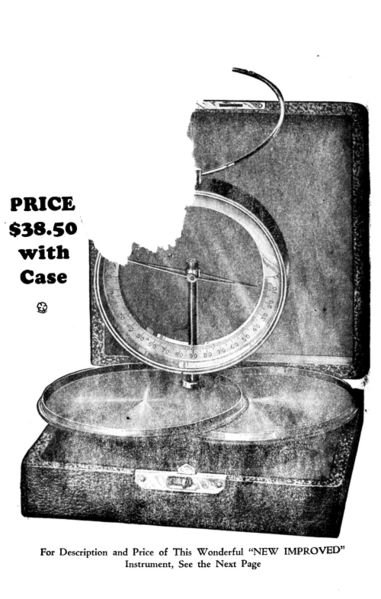 For a description of this wonderful, "NEW IMPROVED" instrument,
see the next page -- although it will tell you what's so great about this particular dip needle, it doesn't really say how to use it (although, if you buy it, they will send instructions with). Dip needles are essentially a compass, but mounted sideways; instead of a magnetic source being measured in the north-south-east-west vein, a dip needle indicates just how close to the horizon a magnetic field line is. Standing on top of one, it points down, but most everything else will be some degree of angle from the horizontal. This particular dip needle has an additional axis, a " z" axis to the compass' x and the dip needle's y. Model also offered a z-less version of the dip needle, for the price-conscious prospector. Given the external amount of magnetic influence on our planet just by having a north pole, a dip needle may seem like a fancy form of dowsing, but they do have a history of genuine use. Today, we use magnetically tuned electronics to find buried metals, but in 1930 these archaic mechanical devices were the state-of-the-art technology for prospectors. Dip needles have shown to be successful in prospecting for magnetic and conductive metals, but for obvious reasons not particularly effective for finding gems, oil, or coal. In theory, a small dip needle like above (about 3-½ inches across) is not likely to be sensitive enough to find nuggets or coins, but people claim to have success in finding largish metallic deposits with them. At first glance, the interest in prospecting in 1930 seemed to me to be Depression-related, but by the 1920s prospecting as an individual sport was declining, having far more popularity fifty years earlier. The gold rushes of the 19th century were fading, but still recent enough to encourage people to believe that another mother lode was just waiting to be found. Labels: aparratus, dip needle, dowsing, gold, model publishing company, prospecting, science
|  |
|
|
